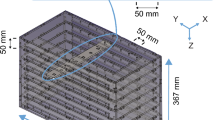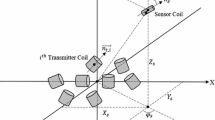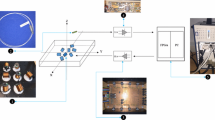Abstract
Purpose
Navigation in high-precision minimally invasive surgery (HP-MIS) demands high tracking accuracy in the absence of line of sight (LOS). Currently, no tracking technology can satisfy this requirement. Electromagnetic tracking (EMT) is the best tracking paradigm in the absence of LOS despite limited accuracy and robustness. Novel evaluation protocols are needed to ensure high-precision and robust EMT for navigation in HP-MIS.
Methods
We introduce a novel protocol for EMT measurement evaluation featuring a high-accuracy phantom based on LEGO\(^{\circledR }\), which is calibrated by a coordinate measuring machine to ensure accuracy. Our protocol includes relative sequential positions and an uncertainty estimation of positioning. We show effects on distortion compensation using a learned interpolation model.
Results
Our high-precision protocol clarifies properties of errors and uncertainties of EMT for high-precision use cases. For EMT errors reaching clinically relevant 0.2 mm, our design is 5–10 times more accurate than previous protocols with 95% confidence margins of 0.02 mm. This high-precision protocol ensures the performance improvement in compensated EMT by 0.05 mm.
Conclusion
Our protocol improves the reliability of EMT evaluations because of significantly lower protocol-inherent uncertainties. To reduce patient risk in HP-MIS and to evaluate magnetic field distortion compensation, more high-accuracy protocols such as the one proposed here are required.











Similar content being viewed by others
References
Franz AM, Haidegger T, Birkfellner W, Cleary K, Peters TM, Maier-Hein L (2014) Electromagnetic tracking in medicine: a review of technology, validation, and applications. IEEE TMI 33(8):1702–1725
Gudbjartsson H, Patz S (1995) The rician distribution of noisy MRI data. Magn Reson Med 34(6):910–914
Haidegger T, Fenyvesi G, Sirokai B, Kelemen M, Nagy M, Takács B, Kovács L, Benyó B, Benyó Z (2011) Towards unified electromagnetic tracking system assessment-static errors. EMBC Proc 2011:1905–1908
Hummel J, Figl M, Birkfellner W, Bax MR, Shahidi R, Maurer CR, Bergmann H (2006) Evaluation of a new electromagnetic tracking system using a standardized assessment protocol. Phys Med Biol 51(10):N205–10
Hummel JB, Bax MR, Figl ML, Kang Y, Maurer C, Birkfellner WW, Bergmann H, Shahidi R (2005) Design and application of an assessment protocol for electromagnetic tracking systems. MedPhys 32(7):2371–2379
Joint Committee for Guides in Metrology (2008) Evaluation of measurement data—guide to the expression of uncertainty in measurement
Kindratenko VV (2000) A survey of electromagnetic position tracker calibration techniques. Virtual Real 5(3):169–182
Koivukangas T, Katisko JP, Koivukangas JP (2013) Technical accuracy of optical and the electromagnetic tracking systems. SpringerPlus 2(1):90–96
Kügler D, Stefanov A, Mukhopadhyay A (2018) i3posnet: i9nstrument pose estimation from X-ray. arxiv:802.09575
Labadie RF, Balachandran R, Mitchell J, Noble JH, Majdani O, Haynes D, Bennett M, Dawant BM, Fitzpatrick JM (2010) Clinical validation study of percutaneous cochlear access using patient customized micro-stereotactic frames. Otol Neurotol Off Publ Am Otol Soc Am Neurotol Soc Eur Acad Otol Neurotol 31(1):94
Lugez E, Sadjadi H, Pichora DR, Ellis RE, Akl SG, Fichtinger G (2015) Electromagnetic tracking in surgical and interventional environments: usability study. IJCARS 10(3):253–262
Maier-Hein L, Franz AM, Birkfellner W, Hummel J, Gergel I, Wegner I, Meinzer HP (2012) Standardized assessment of new electromagnetic field generators in an interventional radiology setting. MedPhys 39(6):3424–3434
Reichl T, Gardiazabal J, Navab N (2013) Electromagnetic servoing-a new tracking paradigm. IEEE TMI 32(8):1526–1535
Rice SO (1945) Mathematical analysis of random noise. In: Wax N (ed) Selected papers on noise and stochastic processes. Dover Publications Inc., New York, pp 133–294
Sadjadi H, Hashtrudi-Zaad K, Fichtinger G (2016) Simultaneous electromagnetic tracking and calibration for dynamic field distortion compensation. IEEE TBME 63(8):1771–1781
Schipper J, Aschendorff A, Arapakis I, Klenzner T, Teszler CB, Ridder GJ, Laszig R (2004) Navigation as a quality management tool in cochlear implant surgery. JLO 118(10):764–770
Sirokai B, Kiss M, Kovács L, Benyó B, Benyó Z, Haidegger T (2012) Best practice in electromagnetic tracking system assessment. In: II Proceedings of the joint workshop on new technologies for CRAS, vol 12, pp 1–4
Sładek JA (2016) Coordinate metrology: accuracy of systems and measurements, 1st edn. Springer, Berlin
Vakharia VN, Sparks R, O’Keeffe AG, Rodionov R, Miserocchi A, McEvoy A, Ourselin S, Duncan J (2017) Accuracy of intracranial electrode placement for stereoencephalography: a systematic review and meta-analysis. Epilepsia 58(6):921–932
Wilson E, Yaniv Z, Zhang H, Nafis C, Shen E, Shechter G, Wiles AD, Peters T, Lindisch D, Cleary K (2007) A hardware and software protocol for the evaluation of electromagnetic tracker accuracy in the clinical environment: a multi-center study. In: SPIE proceedings, SPIE, p 65092T
Wimmer W, Venail F, Williamson T, Akkari M, Gerber N, Weber S, Caversaccio M, Uziel A, Bell B (2014) Semiautomatic cochleostomy target and insertion trajectory planning for minimally invasive cochlear implantation. BioMed Res Int 2014:596498
Acknowledgements
This research was partially funded by the German Research Foundation Grant No. (FE 431/13-2).
Author information
Authors and Affiliations
Corresponding author
Ethics declarations
Conflict of interest
The authors declare that they have no conflict of interest.
Research involving human participants and/or animals
This article does not contain any studies with human participants or animals performed by any of the authors.
Informed consent
This articles does not contain patient data.
Additional information
Publisher's Note
Springer Nature remains neutral with regard to jurisdictional claims in published maps and institutional affiliations.
Rights and permissions
About this article
Cite this article
Kügler, D., Krumb, H., Bredemann, J. et al. High-precision evaluation of electromagnetic tracking. Int J CARS 14, 1127–1135 (2019). https://doi.org/10.1007/s11548-019-01959-5
Received:
Accepted:
Published:
Issue Date:
DOI: https://doi.org/10.1007/s11548-019-01959-5




